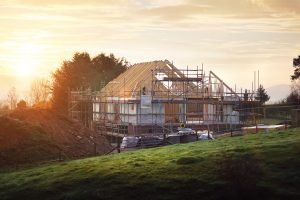 The latest Home Building Geography Index (HBGI) from the National Association of Home Builders (NAHB) for Q2 of 2021 has found that residential construction continued to shift toward the suburbs and lower-cost markets, a trend especially pronounced within the multifamily sector.
The latest Home Building Geography Index (HBGI) from the National Association of Home Builders (NAHB) for Q2 of 2021 has found that residential construction continued to shift toward the suburbs and lower-cost markets, a trend especially pronounced within the multifamily sector.
During Q2 of 2021, multifamily construction posted double-digit percentage gains in small metro core and suburban areas, while large metro areas experienced a decrease for multifamily building activity.
“The trend of construction shifting from high-density metro areas to more affordable regions, which accelerated at the beginning of the pandemic early last year, appears to be continuing,” said NAHB Chairman Chuck Fowke. “Lower land and labor costs, and lower regulatory burdens in suburban and exurban markets make it more appealing to build in these communities. And workers are increasingly flocking to these areas due to expanded teleworking practices and lower housing costs.”
Key Findings in the Q2 2021 HBGI include:
- Single-family home building posted comparable double-digit gains in all seven regional submarkets.
- Core counties of metro areas experienced considerable shrinking of their market shares of total multifamily residential construction activity–from 40.2% in Q1 2021 to 38.7% in Q2 2021.
- Multifamily growth rates were moderately higher in counties that had more affordable housing, which was also evident in the previous quarter.
- In the ongoing pandemic, the most- and least-affordable counties lost market share in single-family home building to counties that placed in the middle three quintiles of housing affordability, dropping from 50.9% in Q4 2019 to 48.3% in Q2 2021.
“There was a marked increase in new apartment construction outside large metro areas as people have greater flexibility to live and work in more affordable markets,” said NAHB Chief Economist Robert Dietz. “Similarly for the single-family sector, the HBGI data revealed that construction growth occurred more proportionally in these more affordable areas as well, while declining in terms of market share in the most expensive counties. However, overall single-family starts have slowed in recent months largely because of rising prices and limited availability of a broad range of key building materials.”
The HBGI for Q2 2021 features a new segmentation of the housing market based on measures of housing affordability using the ratio of the median value of all owner-occupied housing units in a U.S. county, relative to the median income of all residents in that county, as reported in the 2019 five-year American Community Survey. The housing market is then delineated into five submarkets of varying affordability, with each submarket defined as a quintile of all U.S. counties’ price-to-Income ratios.
- Total population for the least-affordable counties: 161 million; 49.9% of total U.S. population
- Total population for the most-affordable counties: 9 million; 2.8% of total U.S. population
NAHB observed the following in the least-affordable counties (Top Price-to-Income quintile):
- 47.6% of single-family construction for 2Q 2021
- 11.1% single-family quarterly growth rate for the 2Q 2021
- 46.3% single-family year-over-year growth rate (2Q 2021 vs. 2Q 2020)
- 25.8% single-family four-quarter MA of the year-over-year growth rate
And in the most-affordable counties (Bottom Price-to-Income quintile):
- 0.7% of single-family construction for 2Q 2021
- 43.9% single-family quarterly growth rate for the 2Q 2021
- 29.9% single-family year-over-year growth rate (2Q 2021 vs. 2Q 2020)
- 22.4% single-family four-quarter MA of the year-over-year growth rate
Single-family home building has also experienced a shift toward more affordable markets, though not as pronounced as multifamily. Exurbs and outer suburbs of medium-sized cities accounted for 18.1% of single-family construction in the second quarter–a market share gain of 0.8 percentage points since the fourth quarter of 2019. And while the bulk (45.8%) of single-family construction occurred in core areas of large and medium-sized metros, that share has declined 1.2 percentage points for that period.
According to the Realtor.com’s Monthly Housing Report for August 2021, inventory and new listings improved during the month, with 432,000 newly-listed homes hitting the market during the month, a 4.3% rise in inventory year-over-year.
“Low mortgage rates have motivated homebuyers to endure this year's challenging market and now some buyers are starting to see their persistence pay off. This month, new sellers added more affordable entry-level homes to the market compared to last year, while others began adjusting listing prices to better compete with an uptick in inventory," said Realtor.com Chief Economist Danielle Hale. "It's still a strong seller's market, with homes selling quickly at record-high prices. But now a home priced well and in good condition may see two or three bids compared to 10 last year. For sellers not seeing as many offers, it may be worth revisiting pricing strategies, as buyers continue searching for homes that fit their budgets."

 theMReport.com Your trusted source for mortgage banking news
theMReport.com Your trusted source for mortgage banking news








